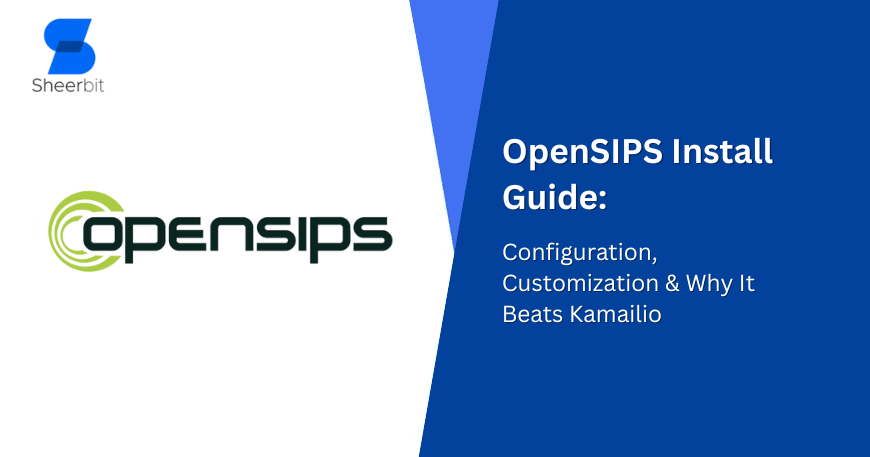Are you looking for a SIP server that you can depend on for your VoIP, WebRTC, or real-time communications projects that is efficient, flexible, and scalable? If so, you have come to the right place. Whether it is about the integration with Asterisk, FreeSWITCH, or Docker, or to decide between OpenSIPS or Kamailio, this article will cover all aspects from installation, configuration, and comparison.
Why Choose OpenSIPS?
OpenSIPS is an open-source SIP server that provides tremendous call routing, load balancing, and real-time session control capabilities. It is recognized for its flexibility, rich module support, and level of ease in scripting, so it’s a great solution for:
- VoIP service providers
- SIP trunking and IP telephony solutions
- WebRTC applications
Scalable SIP infrastructure for carriers and startups
OpenSIPS vs. Kamailio: Which One Is Right for You?
Both OpenSIPS and Kamailio originate from the SIP Express Router (SER) project, but over the years, they’ve taken different paths.
| Feature | OpenSIPS | Kamailio |
| Focus | Flexibility & Scripting | High-Performance SIP Routing |
| Config Style | Human-friendly scripting | C-like syntax (steeper learning) |
| Modules | Rich built-in module support | More manual setup needed |
| Best For | Custom routing, VoIP apps | High-speed SIP handling |
| Learning Curve | Moderate | More complex |
Advantages of OpenSIPS:
- Easy to customize routing logic (e.g., Least-Cost Routing)
- Friendly configuration files
- Strong WebRTC support
Works seamlessly with Asterisk, FreeSWITCH, and Docker
Limitations of OpenSIPS:
- Slightly lower raw performance than Kamailio under extreme loads
- Needs tuning for very high-load environments
How to Install OpenSIPS on Debian/Ubuntu
On Debian:
Follow the steps below to install OpenSIPS along with the MySQL module on a Debian 12 system:
bash
# Update system & install dependencies
sudo apt update
sudo apt install -y gnupg2 wget curl
# Add OpenSIPS repo key using gpg
wget -qO - https://apt.opensips.org/opensips-org.gpg | gpg --dearmor | sudo tee /etc/apt/trusted.gpg.d/opensips-org.gpg > /dev/null
# Add OpenSIPS APT repository
echo "deb https://apt.opensips.org/bookworm 3.4-releases" | sudo tee /etc/apt/sources.list.d/opensips.list
# Update and install OpenSIPS with MySQL module
sudo apt update
sudo apt install -y opensips opensips-mysql-module
On Ubuntu:
bash
# Update and install dependencies
sudo apt update
sudo apt install -y wget gnupg2
# Add OpenSIPS repo
wget -O- https://apt.opensips.org/opensips-org.gpg | sudo apt-key add -
echo "deb https://apt.opensips.org/jammy 3.4-releases" | sudo tee /etc/apt/sources.list.d/opensips.list
# Install OpenSIPS with HTTP support
sudo apt update
sudo apt install opensips opensips-http-modules
Running OpenSIPS in Docker
Prefer containers? Here's how to run OpenSIPS in Docker:
bash
docker run -d --name opensips -p 5060:5060/udp opensips/opensips:3.4Basic OpenSIPS Configuration
The heart of OpenSIPS lies in the /etc/opensips/opensips.cfg file. Here’s a minimal config to handle SIP registrations and routing:listen=udp:0.0.0.0:5060 # Listen on default SIP port
loadmodule "usrloc.so"
loadmodule "registrar.so"
route[REGISTER] {
if (!save("location")) {
sl_reply_error();
exit;
}
}
route {
if (!lookup("location")) {
sl_send_reply("404", "User Not Found");
exit;
}
t_relay();
}
Customizing OpenSIPS: Going Beyond Basics
Extend OpenSIPS using powerful modules:- MySQL/PostgreSQL – User authentication, registrations
- MRTPProxy – Essential for WebRTC media handling
- HTTP/JSON – For REST API integration
Example: Enabling WebRTC Support
loadmodule "rtpproxy.so"
loadmodule "websocket.so"
modparam("rtpproxy", "rtpproxy_sock", "udp:localhost:22222")
modparam("websocket", "ws_port", 5066)
Integrating OpenSIPS with Asterisk & FreeSWITCH
OpenSIPS + Asterisk
OpenSIPS can act as a SIP proxy, improving Asterisk’s scalability and security.
route {
if (uri=~"sip:.*@asterisk") {
rewritehost("asterisk-ip");
t_relay();
}
}
OpenSIPS + FreeSWITCH
If you're handling WebRTC, media mixing, or conferencing, FreeSWITCH is the perfect media server to pair with OpenSIPS.
route {
if (uri=~"sip:.*@freeswitch") {
rewritehost("freeswitch-ip");
t_relay();
}
}
Final Thoughts: Is OpenSIPS Right for You?
At Sheerbit, we’ve helped clients around the world deploy custom OpenSIPS solutions and here’s what we’ve learned:
Choose OpenSIPS if you want:
✅ Easy-to-read config files
✅ Custom call routing logic (LCR, ENUM, failover)
✅ Seamless WebRTC integration
✅ A flexible solution that integrates with Asterisk, FreeSWITCH, and Docker
Consider Kamailio if:
- You need ultra-high-performance SIP handling
- You’re comfortable with complex config files
Next Steps for You
- Install OpenSIPS on your preferred OS (Debian/Ubuntu)
- Experiment with routing and registration configs
- Try WebRTC integration using RTPProxy
- Compare results with Kamailio if you’re evaluating options
Are you looking to build a powerful and scalable VoIP or SIP-based communications platform? Sheerbit provides experienced OpenSIPS development services tailored to your business needs.
Whether you’re building a SIP proxy, load balancer, or real-time communications server, at Sheerbit our expert OpenSIPS developers deliver solutions that are robust, secure, and highly performant. From system architecture and design to deployment and maintenance support, we do it all.
Let Sheerbit’s proven experience in OpenSIPS empower your communications infrastructure. Are you ready to scale your communications ecosystems?
Contact Sheerbit today to hire an experienced OpenSIPS developer to help you take your real-time communications to the next level!




